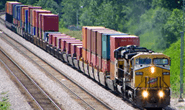Shipping and Logistics

Port Congestion Further Hampering Supply-Chains
Written by David Schollaert
September 14, 2021
Container ships are stacking up all around the U.S. as the ports are overwhelmed by surging imports of all types of goods. Delays at the ports may further extend the already-long lead times for the growing orders of foreign steel.
Imports of all types of products from Asia, for example, increased 32.4% in the first seven months of this year versus the same period in 2020, according to IHS Markit’s PIERS data provider. The double-digit increase is stressing ports already contending with logistics delays and labor shortages, causing vessels to bunch up in the early days of peak shipping season.
According to the Marine Exchange of Southern California, there is now a logjam of more than 50 vessels in Los Angeles-Long Beach awaiting space, with more vessels scheduled to arrive daily. Similar bottlenecks are reported at ports in New York-New Jersey, Seattle, Savannah and others.
Underscoring the severity of the problem, the Port of Philadelphia’s main container terminal took a three-day stoppage to all vessel operations earlier this month to clear out container backlogs. Operator Greenwich Terminals said in a notice that they have not taken lightly the decision to delay vessels. However, they said the best way they can help the trade community is to focus their efforts turning containers and making space for incoming ships. Philadelphia’s total imports rose 23% year over year during the first seven months of 2021.
According to a report from JOC.com, the next three months will be difficult for the ports and their severely taxed inland supply chains. “Within the coming months, carriers are aiming at what can at best be described as a capacity explosion on the trans-Pacific trade,” said Alan Murphy, CEO of Sea-Intelligence Maritime Analysis. “Good for a booming market, but [it] could lead to even worse congestion.”
By David Schollaert, David@SteelMarketUpdate.com

David Schollaert
Read more from David SchollaertLatest in Shipping and Logistics

US Great Lakes iron ore cargoes down notably through May
The Lake Carriers' Association reported a considerable decline in monthly iron ore shipments from US ports on the Great Lakes.

Wittbecker: West Coast port congestion
What's going on in West Coast ports?

Wittbecker: Mexico invests in port capacity despite US tariff troubles
The Mexican government aims to transform Manzanillo into the largest seaport in Latin America, capable of processing some 10 million TEU (20-foot equivalent units) per year by 2030. It is already Mexico's largest port and the third largest in Latin America, handling nearly 4 million 20-foot containers in 2024.

Wittbecker on Aluminum: When do the tariffs reach Main Street?
Containers sailing from China in April are down 15%-20% and Hapag Lloyd says their future bookings transpacific are down 30%.

Wittbecker on Aluminum: US-China trade war clobbers cross-Pacific trade
Container shipping lines have sharply increased blank sailings on Transpacific routes in response to escalating trade tensions between the US and China.
